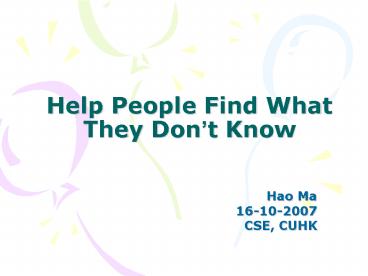Help People Find What They Dont Know - PowerPoint PPT Presentation
1 / 26
Title:
Help People Find What They Dont Know
Description:
How many times do you search every day? ... Copernic, Mooter, Kartoo, Groxis, Clusty, Dogpile, iBoogie,... Vivisimo is surely the best ! ... – PowerPoint PPT presentation
Number of Views:289
Avg rating:3.0/5.0
Title: Help People Find What They Dont Know
1
Help People Find What They Dont Know
- Hao Ma
- 16-10-2007
- CSE, CUHK
2
Questions
?
- How many times do you search every day?
- Have you ever clicked to the 2nd page of the
search results, or 3rd, 4th,,10th page? - Do you have problem to choose correct words to
represent your search queries?
3
Goal of a Search Engine
- Retrieve the docs that are relevant for the
user query - Doc file word or pdf, web page, email, blog,
book,... - Query paradigm bag of words
- Relevant ?
- Subjective and time-varying concept
- Users are lazy
- Selective queries are difficult to be composed
- Web pages are heterogeneous, numerous
- and changing frequently
- Web search is a difficult, cyclic process
4
User Needs
- Informational want to learn about something
(40) - Navigational want to go to that page (25)
- Transactional want to do something (35)
- Access a service
- Downloads
- Shop
- Gray areas
- Find a good hub
- Exploratory search see whats there
SVM
Cuhk
Car rental in Finland
5
Queries
- Wide variance in
- Needs
- Expectations
- Knowledge
- Patience 85 look at 1 page
- ill-defined queries
- Short
- 2001 2.54 terms avg
- 80 less than 3 terms
- Imprecise terms
- 78 are not modified
6
Different Coverage
Google vs Yahoo Share 3.8 results in the top 10
on avg Share 23 in the top 100 on avg
7
In summary
- Current search engines incur in many
difficulties - Link-based ranking may be inadequate bags of
words paradigm, ambiguous queries, polarized
queries, - Coverage of one search engine is poor,
meta-search engines cover more but difficult
to fuse multiple sources - User needs are subjective and time-varying
- Users are lazy and look to few results
8
Two complementary approaches
9
- Web Search Results Clustering
10
An interesting approach
Web-snippet
11
Web-Snippet Hierarchical Clustering
- The folder hierarchy must be formed
- on-the-fly from the snippets because it must
adapt to the themes of the results without any
costly remote access to the original web pages or
documents - and his folders may overlap because a snippet
may deal with multiple themes - Canonical clustering is instead persistent and
generated only once - The folder labels must be formed
- on-the-fly from the snippets because labels
must capture the potentially unbounded themes of
the results without any costly remote access to
the original web pages or documents. - and be intelligible sentences because they must
facilitate the user post-navigation - It seems a document organization into topical
context, but snippets are poorly composed, no
structural information is available for them,
and static classification into predefined
categories would be not appropriate.
12
The Literature
- We may identify four main approaches (ie.
taxonomy) - Single words and Flat clustering
Scatter/Gather, WebCat, Retriever - Sentences and Flat clustering Grouper, Carrot2,
Lingo, Microsoft China - Single words and Hierarchical clustering FIHC,
Credo - Sentences and Hierarchical clustering Lexical
Affinities clustering, Hierarchical Grouper,
SHOC, CIIRarchies, Highlight, IBM India - Conversely, we have many commercial proposals
- Northerlight (stopped 2002)
- Copernic, Mooter, Kartoo, Groxis, Clusty,
Dogpile, iBoogie, - Vivisimo is surely the best !
13
To be presented at WWW 2005
14
SnakeTs main features
- 2 knowledge bases for ranking/choosing the labels
- DMOZ is used as a feature selection and sentence
ranker index - Text anchors are used for snippets enrichment
- Labels are gapped sentences of variable length
- Groupers extension, to match sentences which are
almost the same - Lexical Affinities clustering extension to k-long
LAs
15
SnakeTs main features
- Hierarchy formation deploys the folder labels and
coverage - Primary and secondary labels for
finer/coarser clustering - Syntactic and covering pruning rules for
simplification and compaction - 18 engines (Web, news and books) are queried
on-the-fly - Google, Yahoo, Teoma, A9 Amazon, Google-news,
etc.. - They are used as black-boxes
16
Generation of the Candidate Labels
- Extract all word pairs occurring in the snippets
within some proximity window - Rank them by exploiting KB frequency within
snippets - Discard the pairs whose rank is below a threshold
- Merge repeatedly the remaining pairs by taking
into account their original position, their
order, and the sentence boundary within the
snippets
17
(No Transcript)
18
(No Transcript)
19
(No Transcript)
20
(No Transcript)
21
(No Transcript)
22
- Query Optimization
23
(No Transcript)
24
- Disadvantages
25
- Can we do BETTER???
26
Q A
- The End































